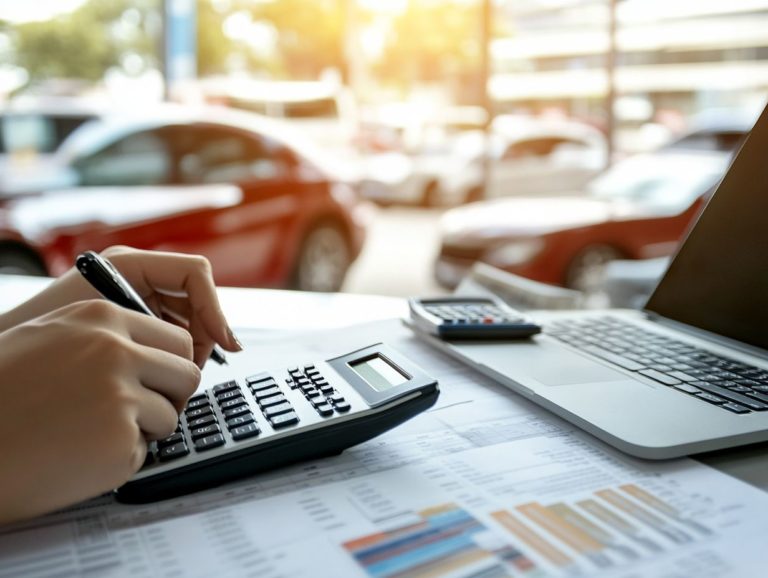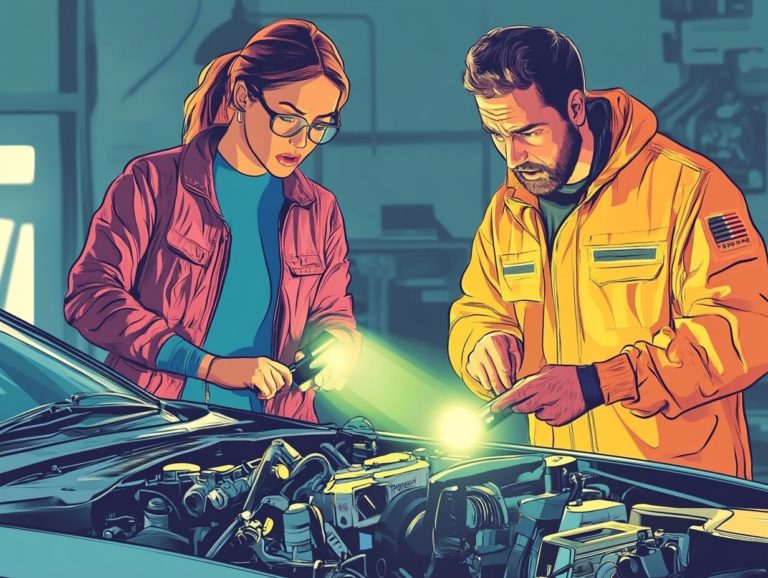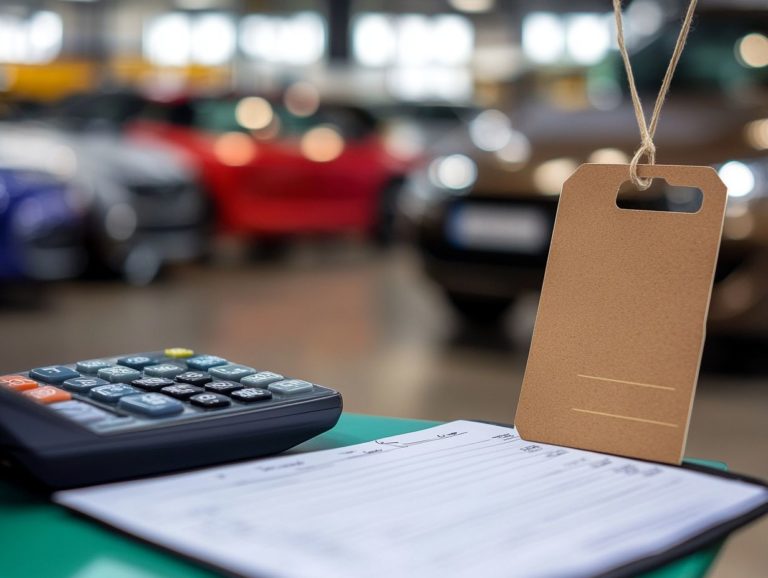How to Check a Used Car’s Tires
Ensuring your vehicle’s tires are in prime condition is vital for both safety and performance. From recognizing the signs of wear and tear to regularly checking tire pressure and tread depth, every element contributes significantly to your driving experience.
Get ready! This guide will arm you with the essential tips to keep your tires in top shape, offering insights for identifying damage and key factors to consider when purchasing a used car.
Continue reading to empower yourself with the knowledge necessary for maintaining optimal tire health!
Contents
- Key Takeaways:
- Why Checking Tires is Important
- Visual Inspection of Tires
- Checking Tire Pressure
- Measuring Tread Depth
- Assessing Tire Age
- Looking for Signs of Damage
- Tips for Buying a Used Car with Good Tires
- Frequently Asked Questions
- What is the importance of checking a used car’s tires?
- How do I visually inspect a used car’s tires?
- What should I look for when checking the pressure of a used car’s tires?
- How can I check the tread wear on a used car’s tires?
- Is it necessary to check the spare tire on a used car?
- Can I trust the tire pressure monitoring system (TPMS) on a used car?
Key Takeaways:
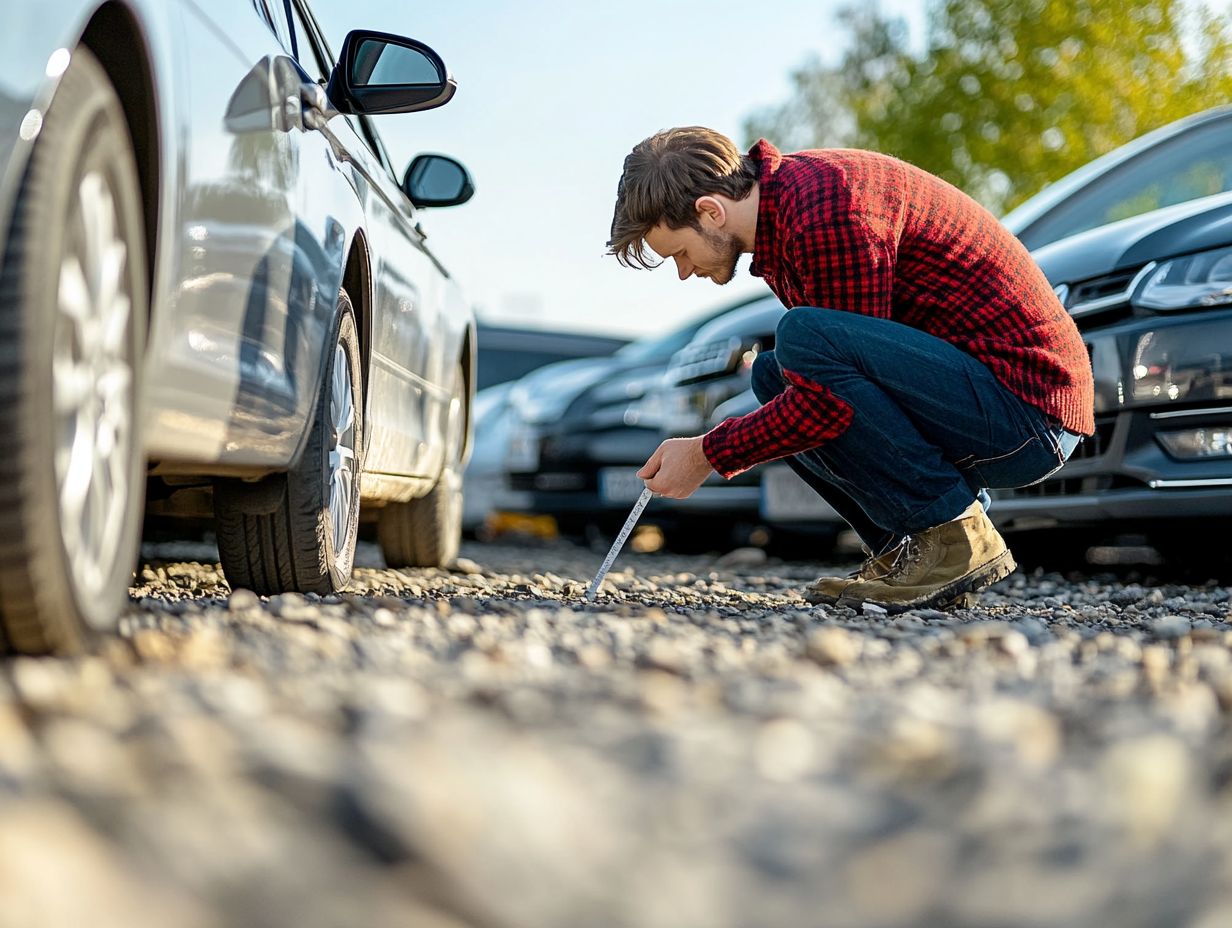
- Regularly checking tires is crucial for the safety and performance of a used car.
- Visually inspect tires for signs of wear and tear.
- Properly inflated tires are essential for optimal performance and longevity.
Why Checking Tires is Important
Checking your tires is essential for ensuring a safe driving experience, especially given the diverse conditions of Canadian roads, from bustling Toronto to the expansive stretches of Calgary.
A thorough tire inspection not only boosts your vehicle’s performance, but it also plays a critical role in overall road safety, particularly during challenging winter months when SUVs are often preferred for their superior handling.
By understanding the details of tire maintenance including the importance of tire age and tread depth measurement you can avoid hazardous situations like blowouts and enhance fuel efficiency, especially for electric cars.
Safety and Performance Considerations
Understanding the safety and performance considerations of your tires is essential for optimal vehicle operation, as they significantly impact both handling and fuel efficiency.
When assessing your vehicle’s overall performance, factors like tire pressure, tread condition, and safety features become increasingly crucial. Regular tire inspections help you spot issues like uneven wear or damage.
Measuring tread depth is vital, as inadequate tread can lead to poor grip in wet or slippery conditions, increasing the risk of accidents. Knowing the legal limits for tread depth is essential for staying compliant and safe.
Choosing quality used tires can save money and improve your driving safety, provided they meet the right standards. This highlights the importance of making informed choices regarding your tire purchases.
Visual Inspection of Tires
Conducting a visual inspection of your tires is one of the simplest yet most effective methods to find potential issues that could hurt your safety or performance on the road.
Signs of Wear and Tear
Recognizing the signs of wear and tear on your tires is crucial for maintaining safe driving conditions. Neglected tires can lead to dangerous situations on the road.
Pay close attention to specific indicators, such as uneven tread wear, cracks, and bulges. These often signal deeper issues that could hurt both your safety and your vehicle’s performance.
For example, uneven tread might indicate misalignment or improper inflation, while cracks could suggest age-related deterioration or exposure to harsh elements. Bulges are particularly concerning, as they can signify internal damage that poses a significant risk, especially at high speeds.
Regularly assessing your tire tread condition helps you identify these warning signs and enhances the overall health of your tires, ensuring a smoother, safer ride.
By being vigilant and attentive to these cues, you can take proactive measures that not only prevent costly repairs but also promote the longevity of your tires.
Checking Tire Pressure
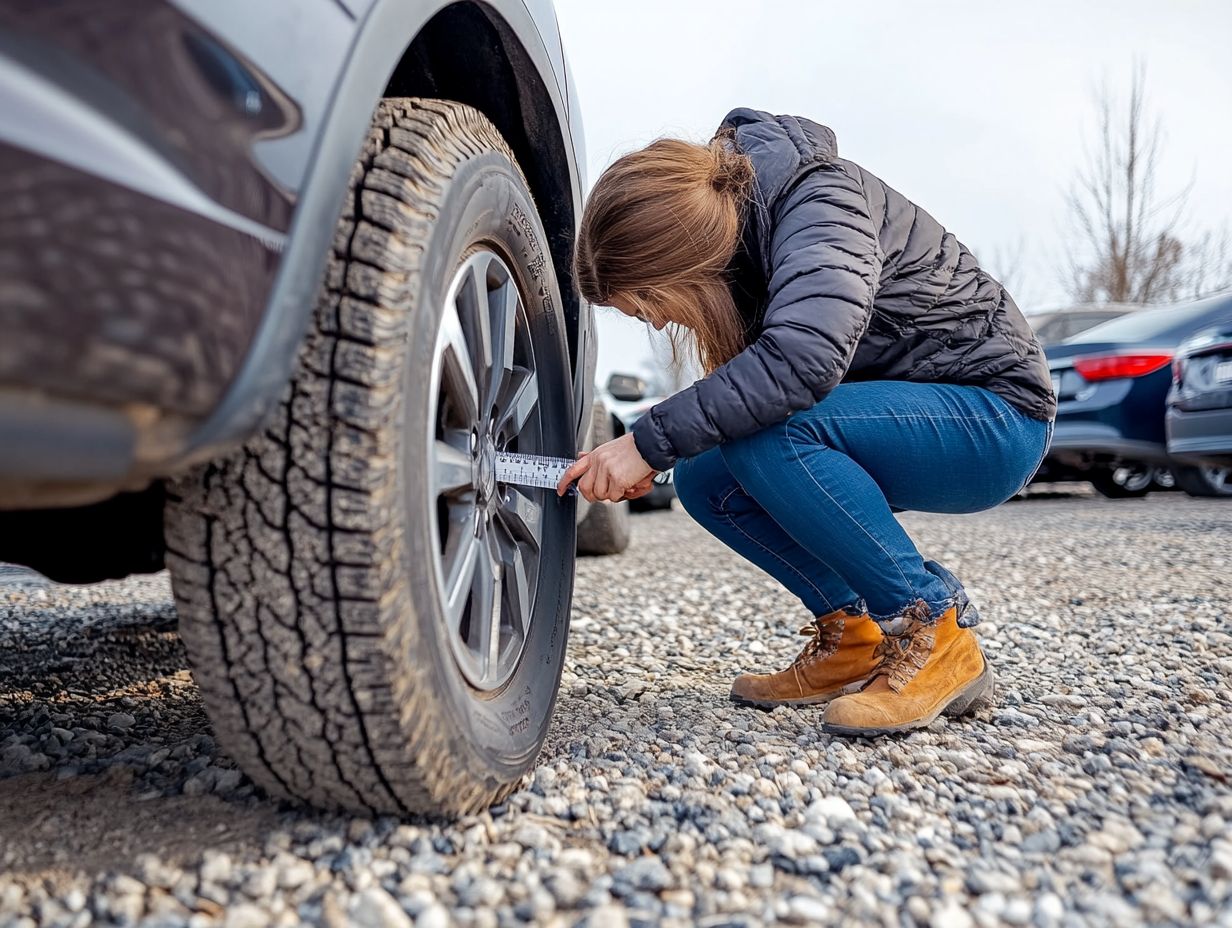
Ensuring your tire pressure is optimal is a fundamental aspect of tire maintenance that significantly impacts both your safety and fuel efficiency. It s a crucial step in the tire inspection process that shouldn t be overlooked.
Don’t wait! Check your tire pressure today for a safer drive!
Importance of Proper Inflation
Properly inflating your tires is not just a matter of safety; it s also a vital step in maximizing fuel efficiency, which can greatly affect your driving costs in the long run.
When your tires are under-inflated, they create unnecessary rolling resistance the force that opposes the motion of your vehicle. This leads to increased wear and tear and diminished handling performance. On the flip side, over-inflated tires can make your ride feel harsher and reduce traction, which can be particularly dangerous in challenging conditions.
To keep your tires at their best, make it a habit to check the pressure regularly ideally once a month and consult your vehicle s manual for specific recommendations. Many modern vehicles have systems that alert you when tire pressure is too low, allowing you to make timely adjustments and enhance your safety on the road.
Measuring Tread Depth
Measuring tread depth is an essential aspect of evaluating your tires’ condition and following safety rules, especially concerning the legal tread depth limit.
Prioritizing this step not only enhances your vehicle’s performance but also safeguards your driving experience.
Tools and Techniques for Accurate Measurement
Utilizing the right tools for measuring tread depth ensures accurate assessments while preventing unsafe driving conditions that can arise from worn tires.
- Digital gauges deliver precise readings at the press of a button, making them user-friendly for both seasoned professionals and everyday drivers.
- Manual tools, such as tread depth gauges or even coins, offer a cost-effective means to evaluate your tire health.
When conducting a tire inspection, it s essential to check multiple points around the tire for uneven wear and measure in several locations to gain a comprehensive understanding of its condition. Regular maintenance routines can significantly enhance your vehicle s safety and overall performance.
Assessing Tire Age
Don t overlook the age of your tires! It’s a key factor that can dramatically affect your safety and performance, particularly when you re considering used tires.
How Old is Too Old?
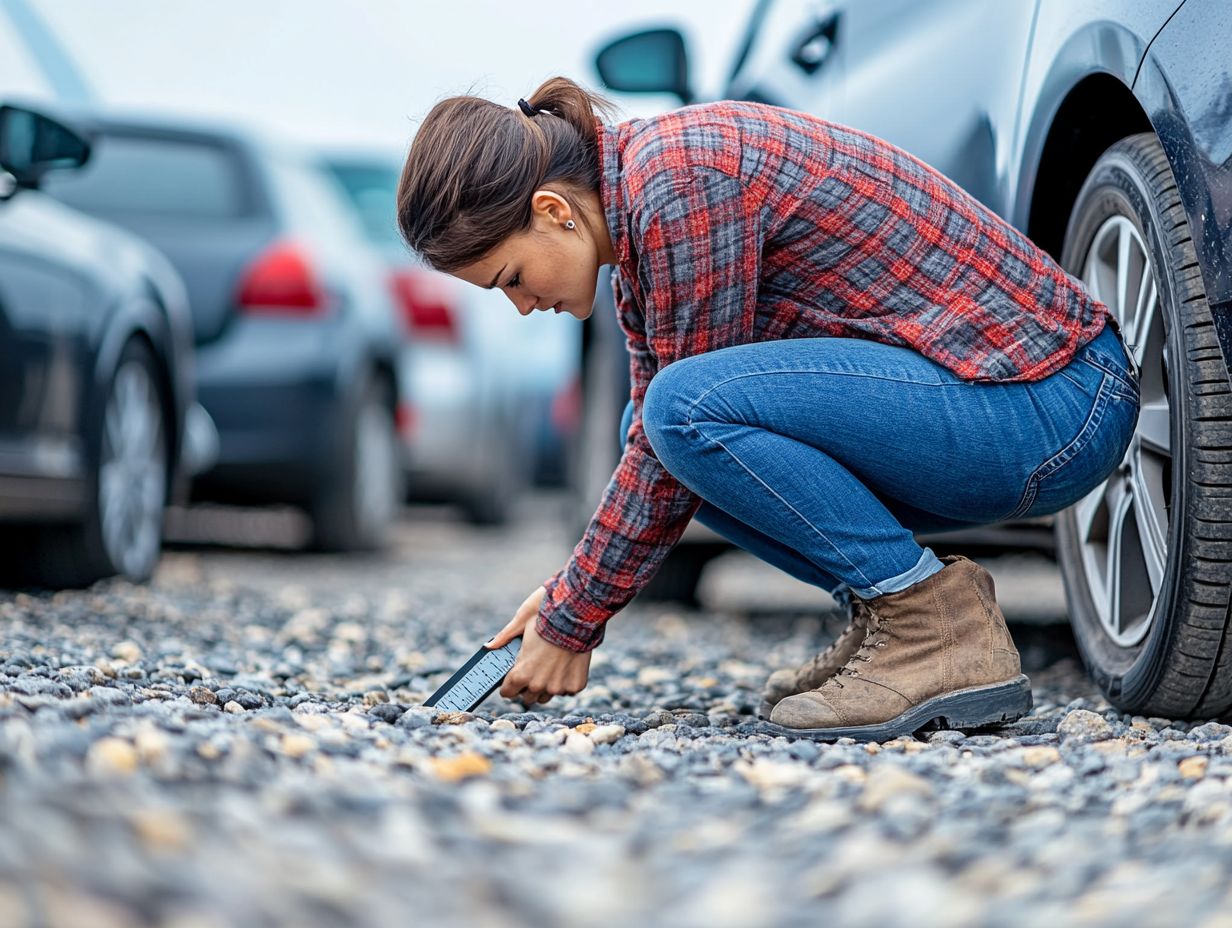
Understanding how old is too old for your tires can be a game changer, helping you avoid potential hazards. The age of your tires can significantly impact their structural integrity and safety features.
Factors like climate, driving conditions, and your maintenance habits play a crucial role in how quickly they degrade. For example, driving in high temperatures can accelerate tire wear. Similarly, hard braking or cornering can put extra stress on the rubber compound, leading to premature aging.
New tires often come loaded with advanced safety features and improved tread patterns that enhance traction and stability. In contrast, older tires might not have these innovations, making them more susceptible to blowouts and hydroplaning.
Regular assessments, like checking tread depth and inspecting for damage, are essential to ensure your tires stay safe and effective throughout their lifespan.
Looking for Signs of Damage
You must recognize signs of damage quickly! This is crucial for keeping your tires in top shape and ensuring your safety on the road.
Common Types of Tire Damage
Common types of tire damage you might encounter include punctures, sidewall damage, and uneven wear. Each type can significantly impact your tire performance and safety. Understanding these challenges is essential.
Punctures often arise from sharp objects on the road and can sometimes be repaired, especially if they’re small and located within the tread. To determine if a puncture is repairable, evaluate its size, position, and depth.
Sidewall damage usually requires replacement. This type of damage often results from hitting a curb or overinflation. The sidewall is crucial for the tire’s strength.
Uneven wear, frequently caused by misalignment or improper inflation, can signal underlying issues. While some wear might be fixed with proper rotation and alignment, severe cases usually need new tires.
Don’t wait! Regular checks can save lives. They help you catch tire problems early and extend tire life.
Tips for Buying a Used Car with Good Tires
When you consider purchasing a used car, it’s vital to ensure it has high-quality tires. For a comprehensive overview, check out what to check before buying a used car. This not only protects your safety but also enhances the vehicle’s overall performance.
What to Look for and Questions to Ask
When you’re in the market for a used car, knowing what to examine regarding the tires is essential. Asking the right questions will help you evaluate a used car’s condition.
The tires are important for both performance and safety. Start by checking the tread depth; tires with insufficient tread can severely compromise traction and handling, especially in wet conditions.
Understanding the age of the tires offers insight into their durability. Tires should generally be replaced every six years, regardless of how much tread remains. Also, inquire about any repairs or damage, as this could influence the tires’ longevity and safety.
A thorough inspection looking for uneven wear or bulges empowers you to make informed purchasing decisions.
Frequently Asked Questions

What is the importance of checking a used car’s tires?
Checking a car’s tires is important because it ensures the safety and performance of the vehicle. Properly inflated and treaded tires provide better traction, handling, and fuel efficiency.
How do I visually inspect a used car’s tires?
Start by looking for visible signs of damage such as cuts, bulges, or cracks on the sidewalls. Next, check the tread depth by using a penny: if Lincoln’s head is partially covered, the tires have adequate tread. If not, it may be time for new tires.
What should I look for when checking the pressure of a used car’s tires?
Refer to the manufacturer’s recommended tire pressure and use a tire pressure gauge to check the pressure on all tires. A significant difference in pressure between tires can indicate alignment or suspension issues.
How can I check the tread wear on a used car’s tires?
You can check the tread wear by looking for the wear bars, which are raised bars located between the treads. If the tread is level with the wear bars, it is time to replace the tires. Alternatively, use a tread depth gauge to measure the tread depth.
Is it necessary to check the spare tire on a used car?
Yes, checking the spare tire is important as it can be crucial in emergencies. Ensure it is properly inflated and has adequate tread. It’s also wise to make sure the spare tire is easily accessible and in good condition.
Can I trust the tire pressure monitoring system (TPMS) on a used car?
While the TPMS can be a useful tool, it is still important to check the tire pressure yourself. The TPMS may not always be accurate and can malfunction, so it s best to double-check with a tire pressure gauge.
Check your tires today and drive safely!

